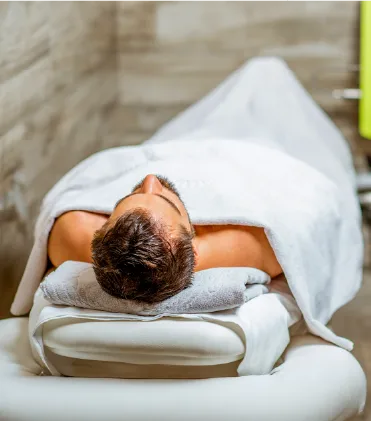What is the Treatment?
Sauna therapy is a treatment in which a person sits in a heated room which is usually covered with wooden blocks. The heated room enclosed with wooden walls helps to increase sweating. In some types of saunas, the rocks are heated at high temperatures and placed in a small room. The high temperature and low humidity of sauna therapy help to relax muscles, detoxify the body and promote a sense of well-being. There are various types of saunas which may include traditional Finnish saunas, infrared saunas, and steam saunas. Each type of sauna has its own benefits and indications.
Philosophy/Origin
Sauna therapy originated in Finland over 2,000 years ago, where it was used for relaxation, healing, and purification. The word "sauna" comes from the Finnish language and it remains an important part of Finnish culture. Today, saunas are used worldwide as a wellness practice to promote physical and mental health.
Physical Benefits
Mental/Emotional Benefits
Long-Term Wellness
Regular sauna sessions help to improve the immunity of the individual. Sauna therapy improves long-term cardiovascular health. It also supports a healthy detoxification process. Metabolism also improves with multiple sessions of sauna therapy.
Ideal Audience
Sauna therapy is ideal for individuals looking for a natural way to relieve stress, detoxify their bodies, and improve overall health. Athletes, those with muscle tension, and people seeking a natural detoxification method may particularly benefit from sauna use.
Specific Conditions
The sauna therapy procedure consists of the following steps:
Consultation
During the consultation, the therapist or spa professional takes the history of the individual to understand their health. The therapist also decides the type of sauna according to the information.
Warming Up
The individual experiences a temperature typically ranging between 150°F to 195°F in traditional saunas. Infrared saunas may have a lower temperature but they have the benefit of deeper penetration into the tissues.
Heat Exposure
The individual will be asked to sit or lie down in the sauna to allow the heat to penetrate their skin and muscles. This step promotes sweating which helps in detoxification and relaxation.
Hydration Breaks
The individual is usually encouraged to stay hydrated to avoid dehydration throughout the session.
Cooling Down
After the sauna session, the individual is guided to cool down in a shower or a pool to regulate their body temperature and close the pores.
Rehydration and Relaxation
Once the body has cooled down, the individual is encouraged to drink water and relax so that the body can fully recover from the exposure to heat.
What to Expect
During a sauna session, individuals feel the heat gradually rise as their body begins to sweat. The environment is peaceful and meditative which allows the body to relax deeply. People experience a feeling of a warm and tingling sensation as circulation increases.
Immediate Effects
Long-Term Effects
Before the Treatment
As the sauna bath is associated with heavy sweating, the therapist asks to stay hydrated and drink plenty of water. It is best to avoid heavy meals before the treatment. Light and comfortable clothing is usually recommended to improve the experience of sauna baths.
Aftercare
The therapist asks to drink water or an electrolyte-rich drink after the sauna session. It is better to gradually decrease the body temperature by light activity after the session. Moisturizing the skin after each session is also beneficial to restore hydration.
Sauna therapy is widely used at spas, wellness centers, and gyms. Traditional Finnish saunas, steam saunas, and infrared saunas offer a variety of options according to health needs and personal preferences. The certified therapist recommends the best type of sauna according to each individual through a platform called Wellencia.









